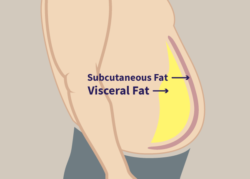 In 2014, GLP-1 agonists were FDA-approved for diabetes in late 2014. The GLP-1 agonists are a newer class of drugs known for their ability to improve blood-sugar control, lower and therefore lower hemoglobin A1c parameters, and decrease co-morbidities associated with insulin insensitivity. Although these medications were designed to treat type II diabetes, some have also been FDA-approved to help with weight loss. The GLP-1 agonists we work with at The Natural Path are called Semaglutide & Tirzepatide. Semaglutide also goes by the brand names Ozempic and Wegovy. Tirzepatide is also known as the branded Mounjaro. These are very effective for those who might be on the border of developing diabetes type 2 and/or other comorbid conditions such as cardiovascular disease, high blood pressure, etc.
In 2014, GLP-1 agonists were FDA-approved for diabetes in late 2014. The GLP-1 agonists are a newer class of drugs known for their ability to improve blood-sugar control, lower and therefore lower hemoglobin A1c parameters, and decrease co-morbidities associated with insulin insensitivity. Although these medications were designed to treat type II diabetes, some have also been FDA-approved to help with weight loss. The GLP-1 agonists we work with at The Natural Path are called Semaglutide & Tirzepatide. Semaglutide also goes by the brand names Ozempic and Wegovy. Tirzepatide is also known as the branded Mounjaro. These are very effective for those who might be on the border of developing diabetes type 2 and/or other comorbid conditions such as cardiovascular disease, high blood pressure, etc.
Potential Benefits of GLP-1 Agonsists (Semaglutide/Tirzepatide) in the Body
- May aid in weight loss
- Delays gastric emptying to help with the feeling of fullness
- Helps to control the livers production of sugar
- Helps the pancreas produce more insulin when your blood sugar levels are high
- Helps control blood glucose
- Can reduce hyperglycemia, especially after meals
- Can reduce fasting insulin and fasting glucose
- Can reduce hemoglobin A1c
- Can decrease appetite and caloric intake, while inhibiting weight gain
- Has been shown to lower triglyceride levels and oxidative stress from high LDL
- Shown to help decrease leptin and increase leptin sensitivity
- Shown to potentially increase the conversion of white fat to brown fat
The addition of GLP-1 agonists to a healthy diet can significantly help the process of weight loss and improve insulin resistance, systolic blood pressure, blood sugar and tricglycerides. This is especially helpful in the patient population that is at a high risk of developing diabetes, as well as other comorbid conditions.
WHAT IS SEMAGLUTIDE & TIRZEPATIDE?
Semaglutide and Tizepatide are known as GLP-1 agonists. This is a class of medication that stands for Glucagon-like peptide 1 agonists. Normally, GLP-1 is secreted in the body when we consume carbohydrates and fats. GLP-1 stimulates the release of insulin, slows gastric emptying, inhibits glucagon, and increases the sense of fullness. Tirzepatide is a GLP-1 agonist but also has effect. Tirzepatide is also a glucose-dependent insulinotropic polypeptide (GIP).
In general, both of those hormones are released when we eat food. When we eat carbs or sugar our body recognizes these nutrients and the GLP-1 and GIP hormones are released. These hormones stimulate our pancreas to release insulin. The appetite center in the brain also recognizes these hormones and most will notice a sense of fullness. This helps patients to regulate their food consumption and hopefully create new habits and patterns with food.
Both Semaglutide & Tirzepatide affect these receptors and causes changes to various hormones involved in regulating appetite and body weight: insulin, glucagon, and leptin.
Leptin
Leptin is a hormone that is produced by your body’s fat cells. It is supposed to tell your brain that — when you have enough fat stored — you don’t need to eat and can burn calories at a normal rate. Leptin’s main role is long-term regulation of energy, including the number of calories you eat and expend, as well as how much fat you store in your body. People who have a lot of excess weight also have high levels of leptin.
Our brains should know that we have plenty of energy stored. Sometimes our leptin signaling doesn’t work and we develop leptin resistance. This is when we have an abundance of leptin, but the brain doesn’t see or recognize it. When your brain doesn’t receive the leptin signal, it mistakenly thinks that your body is starving even though it has plenty of energy stored. This condition is now believed to be one of the main biological contributors to obesity.
Leptin can determine if you lose weight and how much. GLP-1 agonists like Semaglutide and Tirzepatide can help lower leptin resistance. It does this by helping to change the biochemistry of the body and, at the same time, decrease the rise in leptin resistance once you start losing weight. This helps to naturally reduce your appetite, increase your metabolism, and increase fat-burning capacity. Correcting this allows for weight loss to occur and, more importantly, helps you keep off the weight that you have lost.
Insulin
Semaglutide and Tirzepatide also help reduce insulin resistance. Insulin resistance is when cells in your body start resisting or ignoring the signal that insulin is trying to send out—which is to help glucose enter our cells from the bloodstream. Insulin is also a very important hormone involved in weight loss. High insulin levels make it almost impossible for your body to burn fat.
Insulin blocks an enzyme called hormone-sensitive lipase (HSL). This hormone is responsible for the mobilization of fatty acids from fat cell stores. If levels of insulin are high, it blocks this enzyme. Studies show that HSL is decreased in patients with type 2 diabetes mellitus, and this may be a consequence of elevated insulin levels. Excess insulin also has the added problem of promoting fat storage.
Semaglutide and Tirzepatide help sensitize the body to insulin levels and helps to lower blood glucose levels. It also helps reduce fasting insulin and glucose levels. Once insulin levels are stabilized to normal levels this may also improve other hormone imbalances (testosterone for example) which will naturally result in weight loss and a reduction in symptoms associated with those imbalances.
GLP-1 agonists like Semaglutide and Tirzepatide help reduce insulin resistance and lower blood sugar. This then activates hormone-sensitive lipase and results in more fat burning activity over time.
Glucagon
Glucagon helps increase blood sugar levels while insulin lowers blood sugar levels. They are opposites. For hormone-sensitive lipase (fat burning enzyme) to be activated, insulin and glucagon (from glycogen stores) need to be at relatively low levels. High glucagon can also interfere with normal glucose control which in turn can alter how your body burns energy.
Semaglutide and Tirzepatide and other GLP-1 agonists help reduce glucagon levels while simultaneously reducing insulin resistance. Both of these changes promote more normal blood glucose levels and help promote proper liver metabolism of glucose and help adipose tissue burn fat. Glucagon is just as important in the regulation of glucose levels in the body. Treating both insulin and glucagon leads to normal glucose levels and weight loss.
Semaglutide and Tirzepatide help naturally improve your metabolism over time, probably through its effects on leptin levels. Leptin feeds back to your hypothalamus and helps set your body set point – the number of calories your body burns which in turn alters your appetite.
SIDE EFFECTS OF GLP-1 AGONISTS (Semaglutide/Tirzepatide)
In clinical trials, the most common side effects observed in patients treated with these medications were nausea, low blood sugar, diarrhea, constipation, vomiting, headache, decreased appetite, upset stomach, fatigue, dizziness, and abdominal pain.
In addition, some patients who took these medications reported other side effects including pancreatitis, gallbladder disease and renal impairment. You should stop taking it if you notice an increase in your resting heart rate that continues over time.


 In 2014, GLP-1 agonists were FDA-approved for diabetes in late 2014. The GLP-1 agonists are a newer class of drugs known for their ability to improve blood-sugar control, lower and therefore lower hemoglobin A1c parameters, and decrease co-morbidities associated with insulin insensitivity. Although these medications were designed to treat type II diabetes, some have also been FDA-approved to help with weight loss. The GLP-1 agonists we work with at The Natural Path are called Semaglutide & Tirzepatide. Semaglutide also goes by the brand names Ozempic and Wegovy. Tirzepatide is also known as the branded Mounjaro. These are very effective for those who might be on the border of developing diabetes type 2 and/or other comorbid conditions such as cardiovascular disease, high blood pressure, etc.
In 2014, GLP-1 agonists were FDA-approved for diabetes in late 2014. The GLP-1 agonists are a newer class of drugs known for their ability to improve blood-sugar control, lower and therefore lower hemoglobin A1c parameters, and decrease co-morbidities associated with insulin insensitivity. Although these medications were designed to treat type II diabetes, some have also been FDA-approved to help with weight loss. The GLP-1 agonists we work with at The Natural Path are called Semaglutide & Tirzepatide. Semaglutide also goes by the brand names Ozempic and Wegovy. Tirzepatide is also known as the branded Mounjaro. These are very effective for those who might be on the border of developing diabetes type 2 and/or other comorbid conditions such as cardiovascular disease, high blood pressure, etc.